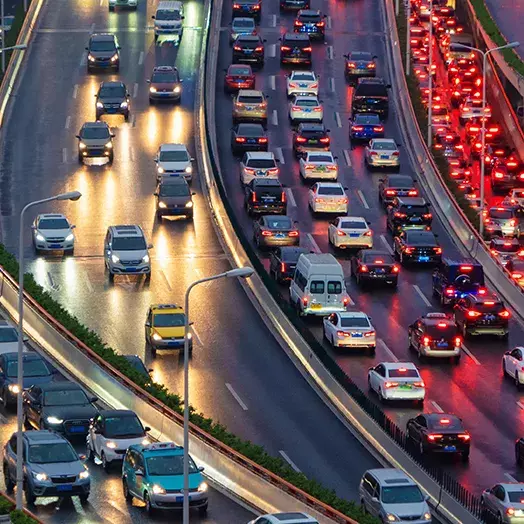Assistant Professor Yuexing Li explores the unintended consequences of adding more environmentally friending ride-sharing vehicles to the roads. Under certain conditions, increasing the number of green ride-hailing vehicles could make emissions worse.

The unintended consequences of green ride-hailing
On a visit home to Beijing, China, three years ago, Yuexing Li looked out the window of his taxi and noticed a significant increase in traffic congestion from his previous time in China before COVID-19.
“I observed a lot more cars with green license plates this time, meaning they were environmentally friendly electric vehicles, and many of them were ride-hailing vehicles,” recalls Li, an assistant professor of operations management and business analytics at Johns Hopkins Carey Business School. “This got me wondering whether adding ‘green’ vehicles to the ride-hailing platform really does reduce overall emissions.”
It's a timely question, given that the transportation sector accounts for roughly 20% of worldwide greenhouse gas emissions, and the global ride-hailing market is expected to reach $126 billion this year, he notes. So, Li — with N. Bora Keskin of Duke and Nur Sunar of the University of North Carolina at Chapel Hill — set out to explore the issue. Ultimately, they developed a theoretical model to analyze how adding green vehicles to ride-hailing platforms affects the environment and consumer surplus.
“We found that contrary to common belief, adding green vehicles to a ride-hailing platform may increase emissions under certain conditions,” says Li, whose conclusions appear in the working paper “Green Ride-Hailing: Impact on Environment and Consumers.”
What to Read Next

Innovation and technology
AI and the future of citiesThe perils of ‘dead-heading’
Just what are those conditions?
Key to the researchers’ theoretical framework, which factors in both gas-fueled and electric vehicles (zero emissions), is drivers’ decisions to serve local customers or to “reposition” to serve riders in a different location. Their model also includes pricing, which is impacted by supply and demand.
Li and the team found that if two locations have very different levels of demand for ride-hailing, adding more green vehicles may help reduce overall emissions. That’s because high-demand locations have much higher prices for ride-hailing services, and the added green vehicles can significantly decrease the price difference across locations, discouraging drivers from repositioning to search for higher prices. As a result, drivers will effectively decide to stay put.
“But bad things happen if the two locations are relatively balanced in terms of demand, with comparable population size and comparable pricing,” says Li. “In this case, the ‘repositioning effect’ can become dominant as more drivers move their empty cars to new locations in search of higher pricing.” This practice of traveling without passengers, known as “dead-heading” in the context of ride-hailing, contributes to higher emissions.
“So, if the demand for ride-shares in two different locations is comparable, we have to ask ourselves: Is it really necessary to add green vehicles to the system? It may encourage drivers to reposition with empty vehicles, thereby increasing the number of cars en route and the vehicle traveling time,” notes Li. “This leads to an overall increase in emissions.”
Li says he was surprised by that finding and even more surprised to subsequently determine that this “congestion effect” — inherent to two “balanced” locations — represents a particularly salient and prevalent case in the team’s theoretical findings.
The takeaway? “To reduce emissions,” Li says, “the platform needs to judiciously choose the number of green vehicles to add at a particular location, and this choice could depend on the baseline demands at different locations.”
When there’s value in a green markup
The researchers also found market conditions for which a green markup could benefit the environment through lower emissions.
In this case, the relevant factors include whether riders are protective of the environment (represented by high demand for green rides) and whether they are sensitive to price increases. “Here again, our findings tie back to the repositioning effect,” he says.
If riders live in a location that values the green car option and are sensitive to price changes, “then drivers should charge a markup for green rides,” Li found. That’s because riders are already inclined to choose a green ride and will be willing to pay more.
In contrast, he says, “Offering a discount for green rides in this case will drive up demand for green vehicles very rapidly, leading more drivers of all cars to participate — which prompts more repositioning and congestion, generating more emissions.”
“On the other hand, if riders are not very protective of the environment, offering a discount for green rides could help reduce overall emissions,” Li says.
A need for prudent planning
To confirm the robustness of their findings, Li and his colleagues investigated several “extensions” in their modeling, including the case of more than two locations, independent pricing for regular and green vehicles, pricing for profit maximization, and replacing regular vehicles while adding green vehicles.
Even within these scenarios, Li says, their central insights hold up.
“At first glance, adding green vehicles to ride-hailing fleets appears to be an intuitive step toward emission reduction,” he notes. “But ride-hailing platforms and policymakers should make prudent decisions about introducing green vehicles to reduce emissions. Adding green vehicles without careful consideration may lead to unintended consequences.”

